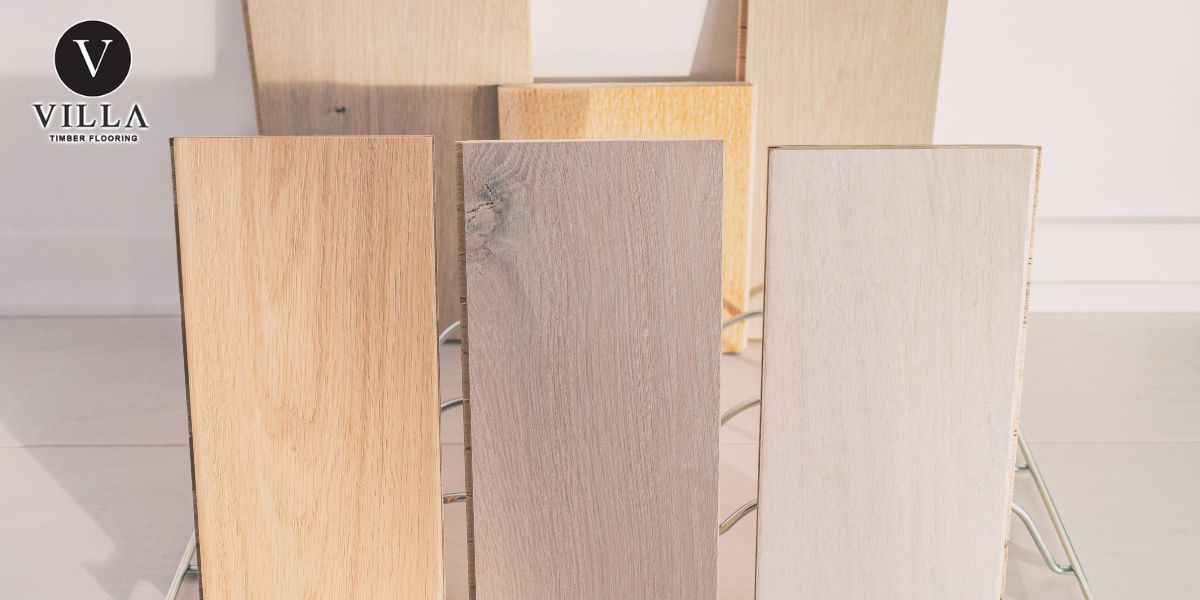Comparing Solid Vs. Engineered Wood Flooring
Friday, 09/08/2024
Administrator
337
09/08/2024, Administrator
337
Wood flooring is one of the popular and preferred choices in modern interior design. The two most widely used types of wood flooring are solid wood flooring and engineered wood flooring. This article by Timber Villa will provide a detailed comparison between solid wood flooring and engineered wood flooring to give you an overview and help you choose the most suitable type for your living space.
1. Solid wood flooring
Solid wood flooring is made from solid wood, undergoing processes like treatment, drying, polishing, and applying a protective coating. This type of flooring offers natural and unique beauty, enhancing the value of living spaces. Let's explore the advantages and disadvantages of solid wood flooring in detail.
1.1 Natural and Unique Beauty
Solid wood flooring stands out with its unique beauty, each plank having distinct grains and colors, creating a luxurious and warm space.
With a variety of wood types and colors, you can easily choose flooring that matches your interior style, from light woods like oak and pine to dark woods like walnut and mahogany.
Wood flooring also brings a close-to-nature feeling, making the living space more relaxing, which is why many families prefer it despite the higher cost.
1.2 High Durability and Longevity
Solid wood flooring is highly durable and long-lasting. With its hardness and good load-bearing capacity, it maintains its quality for many years if properly maintained.
Its high load-bearing capacity ensures the floor does not get damaged under heavy furniture or frequent movement, which is crucial for high-use areas like living rooms.
Moreover, solid wood flooring can be recycled and polished multiple times, restoring its beauty and extending its lifespan, saving replacement costs.
1.3 Environmentally Friendly and Health-Safe
Solid wood flooring is a safe choice for health and environmentally friendly. Made from real wood, it does not contain harmful chemicals found in synthetic materials.
The manufacturing process consumes less energy, and at the end of its lifespan, it can decompose completely without causing pollution.
Solid wood flooring does not emit harmful substances like formaldehyde or VOCs, which is important for families with children, the elderly, or those with respiratory issues.
1.4 Good Thermal and Sound Insulation
Solid wood flooring retains heat well, keeping the space warm in winter and cool in summer, providing comfort and saving energy for heating and cooling systems.
Additionally, solid wood flooring offers effective sound insulation, reducing noise and creating a quiet living environment, which is very useful for apartments or townhouses that need soundproofing.
As a result, its thermal retention and sound insulation capabilities improve health, comfort, and long-term energy cost savings.

2. Engineered Wood Flooring
Engineered wood flooring consists of multiple layers, including a wood base layer, core layer, wood grain layer, and surface coating. This type of flooring offers several advantages over solid wood flooring, suitable for various usage needs. Let's delve into the advantages and disadvantages of engineered wood flooring.
2.1 Reasonable Price and Diverse Options
Engineered wood flooring stands out with its reasonable price, making it accessible to many people. Compared to solid wood flooring, its lower cost helps save initial expenses.
Moreover, the variety of designs and colors of engineered wood flooring, thanks to advanced production technology, allows it to accurately replicate wood grains from various solid wood types, providing many options for consumers.
Additionally, engineered wood flooring comes in various sizes and thicknesses, making it convenient to choose according to project requirements.
2.2 High Stability and Warping Resistance
Engineered wood flooring is more stable than solid wood flooring. Its multi-layer structure reduces the impact of temperature and humidity, limiting warping and shrinkage.
Warping resistance is crucial in areas with fluctuating climates, keeping the floor looking good and maintaining quality for a long time, reducing maintenance costs.
Furthermore, engineered wood flooring is less susceptible to termites due to special treatments during production.
2.3 Easy Installation and Maintenance
Installing engineered wood flooring is faster and simpler than solid wood flooring. Many types have a click-lock system, making installation easy without glue, saving time and costs, and allowing users to do it themselves.
Engineered wood flooring is easier to clean, with a scratch-resistant and water-resistant surface, reducing maintenance effort.
Replacing damaged sections of the floor is also simpler, saving time and repair costs, maintaining overall beauty.
2.4 Excellent Water and Moisture Resistance
A standout feature of engineered wood flooring is its excellent water and moisture resistance. Its multi-layer structure and special coating allow many types of this flooring to withstand high humidity and short-term water exposure without damage.
Engineered wood flooring can be installed in damp areas like kitchens, bathrooms, or basements, where solid wood flooring is unsuitable.
This feature also makes engineered wood flooring easier to clean, as it can be wiped with a damp cloth without worrying about water absorption or warping, which is very useful for families with young children or pets.

3. Detailed Comparison Between Solid wood flooring and Engineered Wood Flooring
Choosing between solid wood flooring and engineered wood flooring can be challenging. To help you get a comprehensive view, here is a detailed comparison based on various criteria.
3.1 Decoration and Material
Solid wood flooring is made entirely from real wood, with unique grains that cannot be replicated. Each plank has its own characteristics, creating a cozy feel for the space. However, the cost is high due to scarce materials and complex manufacturing processes.
Engineered wood flooring uses technology to simulate solid wood grains, reducing costs while offering a variety of designs. Consumers can easily choose colors and styles that match their interiors. Although not as beautiful as natural wood, it still brings a modern and sophisticated look to the living space.
3.2 Durability and Expansion
Solid wood flooring is durable but easily affected by temperature and humidity, leading to shrinkage and warping, requiring frequent maintenance.
Engineered wood flooring has a multi-layer structure, enhancing stability and warping resistance, less sensitive to environmental changes, making it a good choice for high-humidity areas.
3.3 Cleaning and Maintenance
Cleaning and maintenance are essential factors when choosing wood flooring. Solid wood flooring requires meticulous care, including regular sanding and polishing, which is time-consuming and labor-intensive, especially for families with children or pets.
Engineered wood flooring is easier to clean, with a scratch-resistant and water-resistant coating. A simple wipe with a damp cloth is enough without damaging the surface, saving time and keeping the floor looking nice.
3.4 Installation Method and Cost
Installing solid wood flooring requires professional technicians and takes longer, with a complex process needing many tools, leading to higher costs than engineered wood flooring.
Engineered wood flooring has a click-lock system, making installation quick and easy. Users can do it themselves without specialists, saving costs. Engineered wood flooring is generally cheaper, making it suitable for many families.

Conclusion
Choosing between solid wood flooring and engineered wood flooring depends on individual needs and preferences. solid wood flooring offers luxurious and unique beauty but requires more effort in maintenance. Meanwhile, engineered wood flooring provides convenience, stability, and more reasonable pricing. Hopefully, this article gives you more information to make the right decision for your living space.
-
 What is Thermally Modified Wood Flooring? Advantages and Disadvantages09/11/2024
What is Thermally Modified Wood Flooring? Advantages and Disadvantages09/11/2024 -
 Use the correct rubber underlay for your wood floor installations09/11/2024
Use the correct rubber underlay for your wood floor installations09/11/2024 -
 Cost To Install Wood Flooring09/11/2024
Cost To Install Wood Flooring09/11/2024 -
 5 Simple Steps to Install Herringbone Wood Flooring09/11/2024
5 Simple Steps to Install Herringbone Wood Flooring09/11/2024 -
 Kaindl Imported Wood Flooring – A Premium Choice for Your Home05/11/2024
Kaindl Imported Wood Flooring – A Premium Choice for Your Home05/11/2024 -
 Choosing the best Malaysian wood flooring for your home05/11/2024
Choosing the best Malaysian wood flooring for your home05/11/2024 -
 How to Choose Bedroom Flooring05/11/2024
How to Choose Bedroom Flooring05/11/2024 -
 Exploring Premium Black Core Wood Flooring05/11/2024
Exploring Premium Black Core Wood Flooring05/11/2024 -
 Exploring Patterned Wood Flooring29/10/2024
Exploring Patterned Wood Flooring29/10/2024 -
 Comparison of Black Core and Green Core Industrial Wood Flooring29/10/2024
Comparison of Black Core and Green Core Industrial Wood Flooring29/10/2024




















